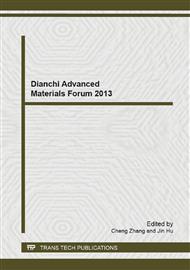p.50
p.56
p.61
p.66
p.70
p.75
p.80
p.84
p.88
First-Principles Study of the ZnO(1120) Structure and Ti Adsorption
Abstract:
Based on the density functional theory, this paper calculated the geometrical and electronic structural properties of ZnO(11¯20) surfaces and analyzed ZnO(11¯20) surfaces in the structural relaxation, electron density difference, densities of states and the Ti adsorption by using the first-principles and pseudopotential method. According to the computing result, ZnO(11¯20) surfaces are similar in geometrical structure and bulk; at the same time, when Ti adsorbs ZnO(11¯20) surfaces, the negative charge density is special high in the central region between Ti and O, and Ti-O shows obviously better performance than Zn-O in covalent bond, for the reason that the number of outer electron transferred from Ti to O is extremely limited, and the area of negative charge of the surface is large, which can lead to metallic characteristics on the surface
Info:
Periodical:
Pages:
70-74
Citation:
Online since:
November 2013
Authors:
Price:
Сopyright:
© 2014 Trans Tech Publications Ltd. All Rights Reserved
Share:
Citation:


